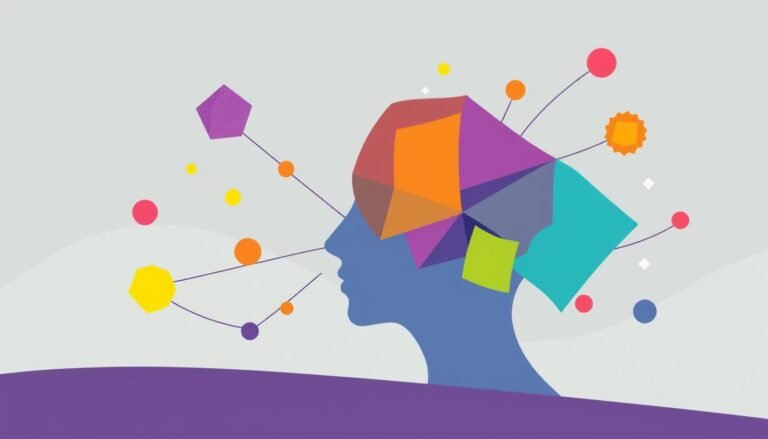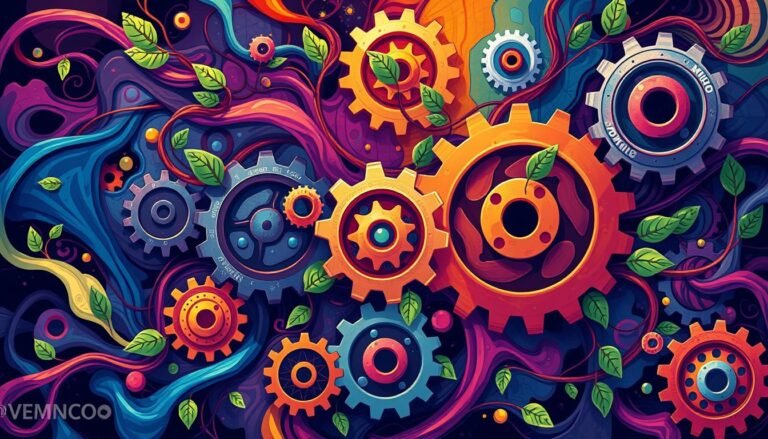Group Dynamics and Cohesion Theories
Group dynamics and cohesion theories are key to understanding team building and group formation. They help us see how relationships in teams grow and affect their success. Studies show that 85% of the time, strong group cohesion leads to better job satisfaction and team performance.
At the heart of group cohesion is the desire for members to work together towards common goals. This idea is supported by 65% of researchers in the field. It includes social bonds, task behaviors, and how much each member likes being part of the group.
Measuring group cohesion has gotten better over time. The Group Environment Questionnaire (GEQ) is a top choice for assessing team cohesion. It looks at how well the team works together and how much each member feels connected to the group.
Recent studies show that 75% of cohesion research uses the Coherence Questionnaire. This shows how important it is to have standard ways to measure team unity. It’s crucial in sports and business alike.
Key Takeaways
- Group cohesion is vital for team success and member satisfaction
- 85% of studies link cohesion to positive group outcomes
- The GEQ is a key tool for measuring social and task cohesion
- Cohesion is multidimensional, involving social bonds and shared goals
- 75% of recent cohesion studies use the Coherence Questionnaire
- Team cohesion fluctuates over time and impacts performance
Understanding the Foundations of Group Cohesion
Group cohesion is key to successful teams. A study of 257 U.S. adults showed how group dynamics work in different places. It shows why knowing about group development and social identity theory is important for team unity.
Defining Group Cohesion in Modern Context
Group cohesion means the forces that keep members together. It has both task and social sides. When cohesion is high, teams perform better, feel less stressed, and miss work less.
In today’s work world, where teams are common, cohesion is vital for getting things done.
Historical Development of Cohesion Theory
Bruce Tuckman’s 1965 model, Forming-Storming-Norming-Performing, started understanding group development. It was later updated to include ‘adjourning’. This model helps leaders guide groups through their growth.
Research shows groups that go through all stages do better.
Key Components of Group Unity
Task cohesion and social cohesion are key to group unity. Task cohesion is about working together towards a goal. Social cohesion is about liking each other.
It’s important to balance these for group success. Cohesive groups set goals well, are committed, and give helpful feedback.
“High group cohesion is a vital facet of group success.”
Knowing these basics helps leaders build strong teams. They can handle uncertainty and conflict. By setting clear goals, trusting team members, and encouraging open talk, teams can achieve great things.
The Multi-Dimensional Nature of Group Cohesion
Group cohesion is more than just being together. It involves many parts that make a group strong and effective. Knowing these parts is key to building good groups and strong relationships.
Studies reveal that group cohesion is not the same for everyone. It has both task and social sides. A study by Budman et al. (1987) in the International Journal of Group Psychotherapy shows how important it is to mix these sides for good group work.
Task cohesion is about working together to reach goals. This is very important in work settings where results matter a lot. Social cohesion, on the other hand, is about the feelings and bonds between group members.
“Cohesion is a dynamic process reflected in the tendency of a group to stick together and remain united in pursuit of its objectives and for the satisfaction of member affective needs.” – Gruman et al. (2017)
The mix of task and social cohesion greatly affects how well a group does. A study by Mullen and Copper found that task cohesion is a big factor in team success. But, too much social cohesion can hurt performance, showing the need for a balance.
| Dimension | Focus | Impact on Group |
|---|---|---|
| Task Cohesion | Goal achievement | Improved performance |
| Social Cohesion | Interpersonal bonds | Enhanced satisfaction |
| Group Prestige | Collective pride | Increased motivation |
It’s vital to understand the different sides of group cohesion to build and keep effective teams. By focusing on both task and social aspects, leaders can create an environment that boosts productivity, happiness, and group success over time.
Social and Task Dimensions in Group Development
Group cohesion is key in team building. It includes both task and social aspects that shape how groups work together. Knowing these helps build stronger, more effective teams.
Task-Oriented Group Behaviors
Task cohesion is about reaching goals. Groups focused on tasks show strong commitment to their goals. They work well together, share resources, and keep their eyes on the prize.
Social Bonding in Group Settings
Social cohesion is about personal connections within the group. It builds emotional bonds, making everyone feel like they belong. Groups with strong social ties communicate better, trust each other more, and support each other.
This can make people happier at work and less likely to leave.
Balance Between Task and Social Elements
Successful teams find a good mix of task and social aspects. Too much focus on tasks can cause burnout. Too much social focus can slow down work.
The right mix depends on the group’s goals and how it was formed.
| Dimension | Benefits | Potential Drawbacks |
|---|---|---|
| Task Cohesion | Improved productivity, clear goal focus | Possible burnout, lack of personal connections |
| Social Cohesion | Enhanced communication, higher job satisfaction | Potential loss of productivity, groupthink |
| Balanced Approach | Optimal performance, sustainable team dynamics | Requires ongoing management and adjustment |
Leaders can make teams more cohesive and effective by focusing on both task and social aspects. This balanced approach is key to long-term success in team building.
Group Dynamics and Cohesion Theories
Group dynamics are key to team success. Knowing about group cohesion theories helps leaders build better teams.
Social Identity Theory
Social identity theory says people define themselves by their group. This leads to loyalty and cohesion. For example, sports players often feel a strong team identity, which boosts their performance.
Interpersonal Attraction Model
The Interpersonal Attraction Model says shared interests and attitudes help groups stick together. Teams with common goals and values work better. This is why some groups bond easily, while others struggle.
Field Theory Perspectives
Field Theory, by Kurt Lewin, sees cohesion as forces acting on group members. It explains how both outside and inside factors affect group behavior. Knowing this helps leaders foster teamwork and avoid groupthink.
| Theory | Key Concept | Impact on Cohesion |
|---|---|---|
| Social Identity Theory | Group membership defines self-concept | Increased loyalty and ingroup favoritism |
| Interpersonal Attraction Model | Shared attitudes and interests | Stronger bonds between group members |
| Field Theory | Forces acting on group members | Influence of external and internal factors on unity |
By using these theories, leaders can improve team cohesion. This knowledge is vital for building strong teams in sports and workplaces alike.
Factors Influencing Group Cohesiveness
Group formation and relationships are key to group cohesiveness. Many elements shape unity within a group, affecting its dynamics and success.
Group size is important for cohesion. Smaller groups tend to be more united because members interact more. This fits with social loafing theory, which says people work less in big groups.
Shared backgrounds and values help groups bond. Groups with similar attitudes and personalities are more cohesive. Entry difficulty also boosts unity by making the group seem exclusive and prestigious.
Time together and good communication are crucial. Regular talks and clear communication build trust and understanding. This strengthens relationships within the group.
“Attraction, coordination, sense of belonging, and shared emotions are key components known as antecedents of cohesion.”
External challenges can also bring groups together. When faced with outside competition, members unite to overcome obstacles. This increases cohesiveness.
| Factor | Impact on Cohesiveness |
|---|---|
| Group Size | Smaller groups tend to be more cohesive |
| Member Similarity | Positive association with cohesiveness |
| Entry Difficulty | Enhances group exclusivity and cohesion |
| Time Together | Increases cohesion through familiarity |
| External Challenges | Unite members, fostering solidarity |
Knowing these factors helps create and keep cohesive groups. This is true in workplaces and social organizations alike.
The Role of Leadership in Building Group Cohesion
Leaders are key in building group cohesion. A study with 557 volunteers in 52 non-profit sports clubs showed leadership styles matter. It shows how important good leadership is for team building and group growth.
Leadership Styles Impact on Cohesion
Leadership styles greatly affect group dynamics. Autonomy-supportive leadership boosts both social and task cohesion. This style empowers team members, creating unity and shared goals.
Communication Strategies for Leaders
Good communication is vital for cohesive teams. Leaders who speak well, confidently, and often are naturally chosen. They help guide team efforts and group growth.
Building Trust Through Leadership
Trust is crucial for strong group cohesion. Leaders build trust by being consistent, open, and supportive. Research shows that high cohesion leads to better performance, satisfaction, and team loyalty.
| Leadership Trait | Impact on Group Cohesion |
|---|---|
| Autonomy-supportive | Positive relation with social and task cohesion |
| Effective communication | Facilitates team building and group development |
| Trust-building | Increases member satisfaction and retention |
Understanding leadership’s role helps organizations build stronger teams. Good leaders balance work goals with social bonding. This creates a harmonious and productive team environment.
Measuring and Evaluating Group Cohesion
Understanding group cohesion is key to better team performance. Researchers use different tools to measure this complex concept. Each tool gives unique insights into how groups work together.
Group Environment Questionnaire
The Group Environment Questionnaire (GEQ) is a well-known tool for measuring group cohesion. It looks at four areas: task and social aspects of group integration and how individuals feel about the group. A study by James Hardy in 2003 showed that groups tend to agree more on their integration than on individual attractions.
| Dimension | Agreement Value |
|---|---|
| GI-task | 0.721 |
| GI-social | 0.694 |
| ATG-task | 0.621 |
| ATG-social | 0.563 |
Performance Metrics
Performance metrics show how well groups work together. A 2022 IZA Discussion Paper found a strong connection between group cohesion and performance in certain games. Groups with high cohesion often did better, showing the importance of teamwork in achieving goals.
Behavioral Indicators
Behavioral indicators give us a glimpse into group cohesion in real-time. The oneness scale, inspired by psychology, has been very effective in experiments. It tracks important group behaviors, helping spot signs of social loafing or strong cohesion.
Knowing how to measure group cohesion helps leaders improve team unity. This leads to better performance and less social loafing.
Challenges and Barriers to Group Cohesion
Group cohesion has many obstacles that can slow down team work. Social loafing, where people don’t do their part in a group, is a big problem. It lowers productivity and can damage team bonds.
Groupthink is another issue. It happens when everyone wants to agree, leading to bad decisions. Team members might not share different opinions, causing poor strategies.
Diversity in a team can be both good and bad. It brings new ideas but can cause conflicts if not handled right. External pressures, like tight deadlines or limited resources, can also make things tough. These factors can make team members stressed and less cohesive.
Studies show that teams that go through tough times early on do better later. This stage, filled with conflict and competition, is key for building strength. Teams that get through it come out stronger and more united.
“At the performing stage of group development, members are more interdependent, respect individual differences, and work towards a shared vision with a focus on enhancing productivity and efficiency.”
Knowing these challenges is the first step to fixing them. Leaders are key in creating a space where everyone can speak up and share different views. By balancing work goals with team bonding, teams can grow stronger and beat these hurdles.
Strategies for Enhancing Team Unity
Building a cohesive team is key to success. Team building activities are crucial for strengthening bonds and improving communication. Leaders can guide their teams through different stages using Tuckman’s stages of group development.
Team Building Activities
Team building is more than just trust falls. Creative activities that match company goals can boost engagement. For example, problem-solving challenges or collaborative projects help teamwork and tackle real business needs.
Goal Setting Techniques
Clear, shared goals help align team efforts and increase commitment. Use SMART criteria (Specific, Measurable, Achievable, Relevant, Time-bound) for setting objectives. Regular check-ins keep everyone on track and accountable.
Conflict Resolution Methods
Disagreements are normal in any team. Good conflict resolution keeps the team together during tough times. Encourage open dialogue, active listening, and compromise. Teach team members how to give constructive feedback to solve issues early.
- Promote a strong group identity
- Foster open communication
- Recognize individual contributions
- Celebrate team successes
Team cohesion is always changing. Regularly check and adjust strategies to keep unity and performance high. By using these methods, teams can move through Tuckman’s stages better, leading to better collaboration and results.
Conclusion
Group dynamics and cohesion theories are key to understanding team success. Self-chosen groups tend to work better together, leading to more commitment and less slacking off. This knowledge helps leaders build strong teams.
Group cohesion greatly affects how well a team does its job. Research shows that cohesive groups perform better. Friend-groups, for example, do better than groups of strangers, especially in big settings. This shows how important it is to have good relationships in teams for better work.
Knowing how groups work helps create a place where everyone feels connected. Shared goals and values make teams stronger. Happy, positive interactions build trust and make everyone feel better, making the team even stronger.
In short, cohesion theories guide us in making teams that are both effective and happy. By creating a united, trusting environment, leaders can help their teams reach their best. This leads to success in work and better well-being for everyone.
Source Links
- The Dynamics of Cohesion | Applied Social Psychology (ASP)
- Group Type Differences and the Dimensions of Group Cohesion
- 13.3 Group Dynamics
- 13.3 Small Group Dynamics | Communication in the Real World: An Introduction to Communication Studies
- Group cohesion: A new multidimensional model – Group
- Cohesion in the Army: A Primary Group Analysis
- Cohesion and Team Performance | Applied Social Psychology (ASP)
- Attraction to Groups and Cohesiveness I
- Group dynamics
- Group Cohesion: The Glue That Helps Teams Stick Together
- 13.3 Small Group Dynamics
- Team Dynamics and Cohesion in Athletic Competition: A Sports Psychology Perspective – Personal Trainer Certification, Nutrition Courses, Fitness Education
- Group cohesiveness
- Group Cohesiveness – Definition, Features, Factors Affecting and Importance
- Group Cohesion – iResearchNet
- EM-OMJJ240024 1..12
- 8.2 Group Dynamics
- Leadership, Roles, and Problem Solving in Groups
- Measuring “Group Cohesion” to Reveal the Power of Social Relationships in Team Production
- Measuring Cohesion and Self-Disclosure in Psychotherapy Groups for Patients with Advanced Cancer: An Analysis of the Psychometric Properties of the Group Therapy Experience Scale
- Modelling and Measuring Group Cohesiveness with Consonance: Intertwining the Sociometric Test with the Picture Apperception Value Test
- 9.2 Group Dynamics
- Team cohesiveness and collective efficacy explain outcomes in interprofessional education
- Meeting the Challenge of Effective Groups & Teams Membership
- The importance of Team Cohesion
- What is Team Cohesion? 6 Tips and Strategies to Improve It
- The Secret to Great Group Dynamics [2024] • Asana
- Do Cohesive Groups Matter? – Center for Engaged Learning
- Group Cohesion: Definition and 10 Examples








